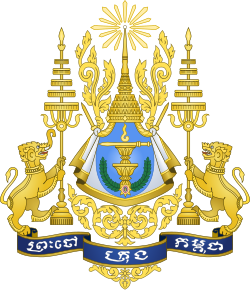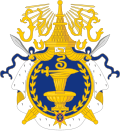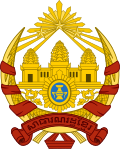This article needs additional citations for verification .(November 2015) |
| Royal Arms of the Kingdom of Cambodia ព្រះរាជសិង្ហានៃព្រះរាជាណាចក្រកម្ពុជា | |
|---|---|
 | |
| Armiger | Norodom Sihamoni, King of Cambodia |
| Adopted | 1953 (original) [1] 1993 |
| Crest | In place of a crest, the Royal Crown of Cambodia Or emitting rays of light Or |
| Shield | Bleu celeste, a sword fesswise Or atop two ceremonial bowls also Or, in chief a representation of the Sacred Aum Or and in base a laurel wreath proper and a representation of the Royal Order of Cambodia also proper |
| Supporters | Two creatures: a Gajasingha and a Singha, both Or, holding two five-tiered royal umbrellas, also Or |
| Compartment | A ribbon Azure with the motto Argent in Khmer script |
| Motto | ព្រះចៅក្រុងកម្ពុជា Preăh Chau Krŏng Kâmpŭchéa ("Ruler of the Kingdom of Cambodia") |
| Order | Royal Order of Cambodia |
The royal arms of Cambodia is the symbol of the Cambodian monarchy. They have existed in some form since the establishment of the independent Kingdom of Cambodia in 1953. It is the symbol on the royal standard of the reigning monarch of Cambodia, currently King Norodom Sihamoni.









